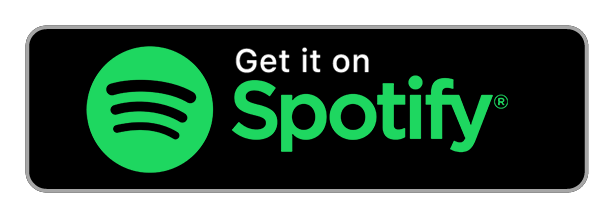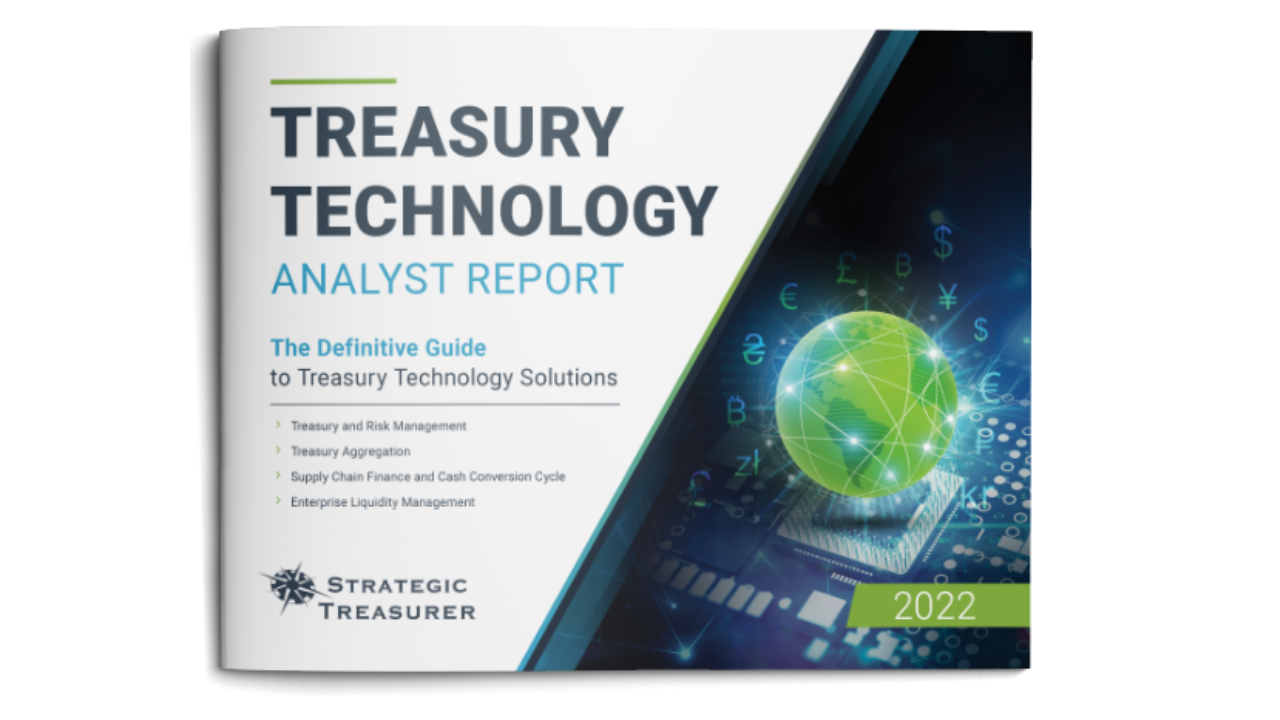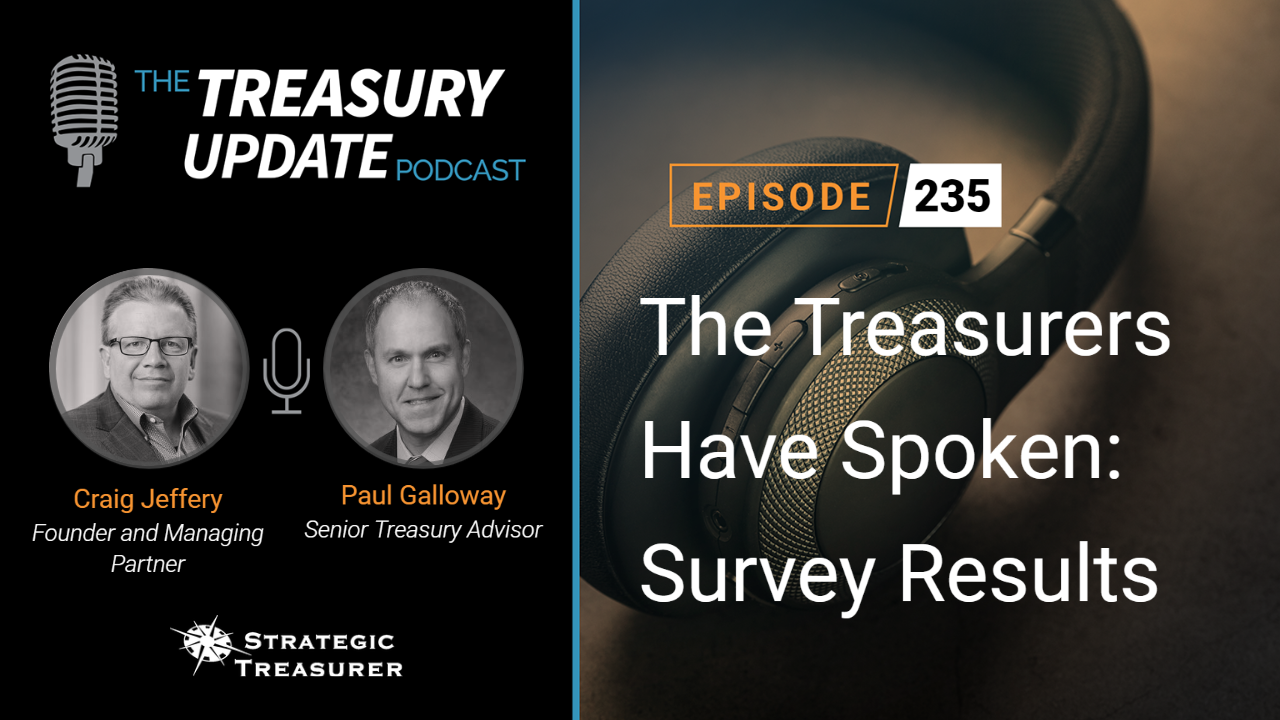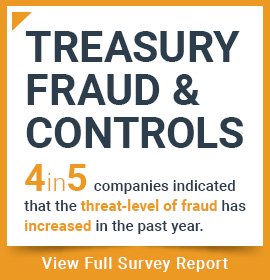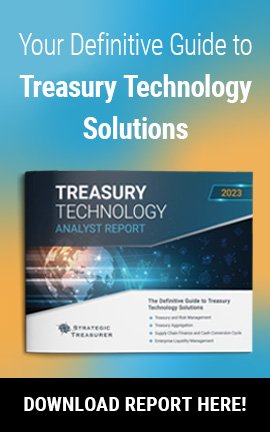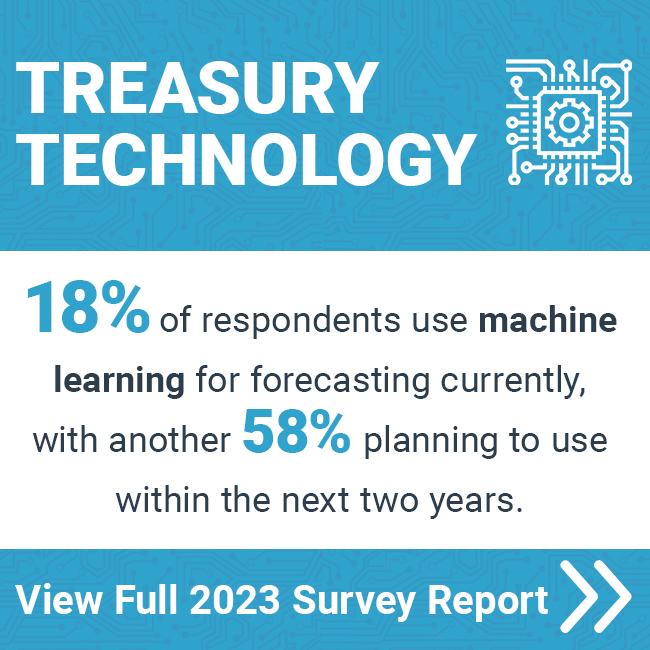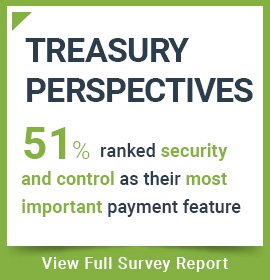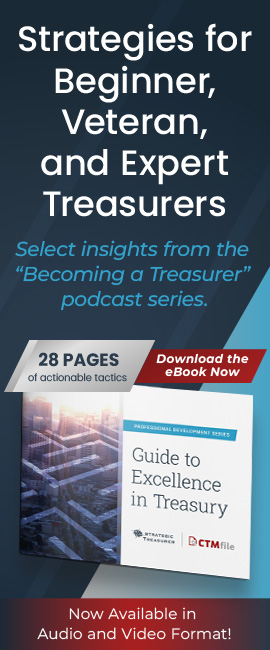
Episode 240
What’s Going on with Interest Rate Activity?
A Treasurer’s Outlook
How do treasurers best position themselves for the future as the Fed continues to raise interest rates? In this podcast, Jason Campbell of Strategic Treasurer discusses the current and future impacts of interest rates with Paul Galloway. Last week, the Fed gave us the first interest rate of 2023. Paul and Jason discuss questions such as, “How do interest rates change?” “Why do changes in interest rates matter?” and “What should treasurers be concerned about?”
Host:
Jason Campbell, Strategic Treasurer


Speaker:
Paul Galloway, Strategic Treasurer


Episode Transcription - Episode #240 - What’s Going on with Interest Rate Activity: A Treasurer’s Outlook
Announcer 00:04
Welcome to the Treasury Update Podcast presented by Strategic Treasurer, your source for interesting treasury news analysis and insights in your car, at the gym, or wherever you decide to tune in.
Jason Campbell 00:18
Welcome to another episode of the Treasury Update Podcast. I’m your host today, Jason Campbell, business development leader here at Strategic Treasurer. I feel very special to be part of this because I’ve only been able to be on this type of podcast outside of the Coffee Break Sessions a couple of times. So I’m really excited to be able to host today’s session. With me today is Paul Galloway, Senior Advisor at Strategic Treasurer. Paul, glad to have you on with me today.
Paul Galloway 00:44
Thanks for having me on here.
Jason Campbell 00:45
You know, Paul, this is a great week of you know, this this week of love Valentine’s Day is this week, hopefully, I’m sure you’ve got something plotted out for your Valentine, I make sure I do well for Valentine’s Day for mine. And, and you know, and I think when we think about love, and we think about gifting and this is a good topic to kind of talk about today, which goes in what the feds have gifted us all, you know, a week ago with some interest rate hikes the first one of 2023 I know that we came through out of 2022 with a few of these hikes already. And you know, kind of looking at, you know, how does this impact whether it’s to start at 2023, or even down the road for 2023. And having this conversation with you around the interest rates and what these impacts are. And what I want to do is just kind of kick it off with, you know, how do interest rates? I’d say how do they change, but also those impacts to the changes? So let’s start off with that.
Paul Galloway 01:45
That’s a great question. You know, it’s it’s fairly broad and open ended. And we’ll talk in generalities around, you know, interest rate changes. The Central Bank of the United States, the Fed has pronounced control over interest rates. So they set the tone, we experienced quite a few interest rate hikes. In 2022. We started out the year, the same philosophy, February 1, they hiked rates, 25 basis points, or what’s known as a quarter percent interest rate hike. So what that means is that the interest rates that will be charged to the target union or it’s a target rate, so they’re targeting, you know, like a bandwidth, currently four and a half to four and three quarter percent interest rates. And what happens is that treasuries that are issued, they’re set setting the benchmark, right, so it’s a benchmark rate, the Fed sets that tone. And then when issuance comes out, it’s issued within, you know, that range that target range. So one month yields, as I’m looking at right now, or hovering around 4.6%. When you look at one year yield is four point 4.86% Roughly, give or take, these interest rates do move in the market. So the Fed sets the tone at benchmark rate, but market rates change. So as a treasury is issued, the yield on that Treasury will move around in a given day. So it doesn’t hold steady. It can be greater than or less than the issuance rate, based on what’s going on in the market. So so the Fed has a lot of things to consider. And so when we were looking at last year 2022, the glaring issue that the Fed was facing, is inflation. And so the thing that the US Fed is always fighting, they’re fighting inflation. We don’t want inflation to get too high, because what that means is that the economy is overheating, prices are rising, wages are rising employment is full, or what they consider to be full employment and perhaps maybe a little bit more than full in terms of where it’s sitting right now. So the Feds trying to, to cool things down. Because inflation gets really high, it means that your economy can overheat. Everything in economic terms becomes more difficult for people over a longer period of time. So keep an at a more low controlled inflation rate. Used to target back in the day 3% For a while that fed was targeting 2% I think they’re gonna get down under that range over a period of time, but I think there’s more interest rate hikes ahead of us, what the Feds done is good, because it will help control those economic factors that are overheating. However, they came out February 1 raised rates 25 basis points. And a couple of days later, employment numbers came out, beating estimates by a wide range in unemployment is now sitting at 3.4%. So going back to my comment earlier, and we talked about full employment, well, we’re there and then some, when the Fed continues to raise rates, what they’re wanting to do is to control the amount of employment out in the market, because we’re actually over employed right now, in essence, for lack of a better term, there’s too much employment out there, employers are fighting to get people to join in their organizations, because of lack of people out there in the market that are available. And so when we’re in that environment, wages start rising to attract more people, which, you know, adds to inflation. And the longer run, which we have not only just employment thing, but we have a lot of the things that are going on around the world, because a whole world is experiences inflation. You look in Europe, inflation has been extremely high there, they hit over 10% last year. So their central bank is doing the same thing. They’re raising rates, even China’s economy has been hit, they have had all kinds of different things that hit them, because they’re so integrated around the world now producing products, it since everything else is getting hit plus supply chain disruptions, COVID war in Ukraine, there’s a lot of factors that go into that. But we’ve had disruption in supply. We’ve had oral pandemic that is starting to subside, and now China has released their zero COVID policy, which now they’re having to deal with the impacts of that in their country. So there’s a lot of factors externally also impact what is going on there. And the Feds trying to control this. So it’s global economic impacts, supply chain affects. Price is increasing as a result of these factors, unemployment all time low, wages increasing, they’re fighting inflation. That’s why we’re raising rates. Now, one could say, is 25 basis points enough? Well, perhaps not. The Fed has a history of making these rate decisions where it’s too much, or it’s too little. So they overcompensate or don’t compensate enough. And it’s it’s very difficult, because they’re looking at all of these different factors, all these different majors, sometimes there, they show conflicting information. Some will be, hey, it’s heading the right direction, doing good and others will be like, Oh, this is not good. And a lot of this is historical looking. It all goes towards how the Fed views rates, what they’re trying to control, which is inflation. So right now, we’re in this increasing rate environment.
Jason Campbell 08:25
So you know, as you think about, you know, you mentioned a lot of great points and bringing in, you know, not just the announcement of raising the rates by 25 basis points, right, but also to them the jobs that come in and the global impacts. And then I don’t know about you, but I could imagine trying to be an economic strategist, in charge of figuring out your challenges to curb inflation, right. And these different economic models, and it almost seems like you kind of mentioned almost like this, this this 25 basis point, you know, will it do something, will it not do something right? And I think it’s, it’s more so of each time that this, these interest rates do rise? It’s, you know, it’s watching See, right, what type of impact does it have, right, it’s gonna have, it’s either going to have three different options, right, you’re gonna be they’re gonna have a positive impact, which is what we’re looking for, you’re gonna have a neutral impact, which no harm no foul, right? Or you have that negative impact, which then you gotta have that, that recourse of that that pullback plan and be able to execute something really, really fast to really try to push it back into the right direction, and minimize the amount of damages.
Paul Galloway 09:27
That’s spot on Jason. A lot of factors that go into this.
Jason Campbell 09:31
You got to be able to the brain surgeon of economics, right to, to kind of the because, I mean, not only domestically, you also got to think about from a global impact. And, you know, how does it impact, you know, other economies, you know, the, as the US dollar is, is how it’s used on a global on a global scale. And so there’s a lot that goes into that and you gotta have all parties getting to green it says, hey, you know, this is going to be the right course, in the right direction. So when you were talking about you brought in how many changes we had in The interest rate changes for 2022. And obviously the one that we just had, at the beginning of February, you know, why did changes in interest rates matter? So why are we so glued to find out when you hear the report that the Fed is going to make an announcement? Right? We’ve almost kind of, we’re kind of glued to our, to our media outlets, and in evaluating workers, so why does it really matter?
Paul Galloway 10:24
There’s several factors or reasons why interest rate changes matter in in the environment, we’re in now, some of the most common factors the treasurer’s consider, or what are the impacts to cost of capital. And so they gotta consider that when they’re thinking about their balance sheet or their liquidity position, and their access to capital in liquidity. So interest rates rise, inherently, the cost associated with issuing new debt or raising capital will increase, generally, that’s what happens in increases. The other thing that also happens is that your liquidity or your costs to raise liquidity, when you have times of stress or, trying to, times of need or just general operating activity, use of liquidity tools to provide cash, when cash is needed, that also increases so your cost, your cost associated with that increases. Some of the other things for treasures to consider, especially ones that have a global footprint. So they have cash flows are coming and going in local currencies. And I say local currencies could be for us local currencies, US dollar, but they could have business in Europe. And so it could be, you know, it could be great British pound, it can be the euro. It could be an agent, maybe it’s Japanese yen, Singapore dollar, it’s a different currency. And as there’s changes in interest rates, and there can be an impact on your currencies. So that’s another factor for them to consider. So they have to think about well, are there things I need to do to fine tune my hedging program for foreign exchange? Do I want to do that? Or do I hope that when rates are being increased last year by the Federal Reserve, we saw that the US dollar we saw initially US Dollar strengthened, and then we ended up as other countries around the world starting increasing rates as well, we saw that come back down. But there was definitely a shift in currency activity or volatility, I think we’re gonna continue to see some FX volatility, now only on the US dollar side, but also on local currency side. So those are factors that are pretty common with changes in interest rates are things that I think treasurer’s will be considering, as the Fed makes his decisions. This also impacts how companies or organizations continue to move their organizations forward. So it could increase the speed with which they’re engaging in terms of new products or services, or it could slow it down, just depending on what their strategy is, or maybe good rationale as to why they would do that. It may be, hey, we’ve got something that we want to do before things, you know, the costs increased too much further, you know, we’re going to execute Now, the other flipside could be, you know, hold weight pattern. And there’s various reasons why they might want to do that. So it can also impact their decision making in terms of how they continue to grow the business rollout new products, make decisions in terms of where they may enter new markets.
Jason Campbell 14:09
You know, I guess it’s day to day we talked about with being an economic strategist and being able to kind of, you know, look at different models to gauge how to move the economy and to keep it in the right side of things. And I think now, go back to what you were just talking about this and also like, think about it from a corporate perspective, right? Like, how much busier are those those corporate executives? You know, whether your your your your chief financial officers or your investment folks, your treasury individuals, like how much busier do they look at their job or their role, career and these past 12, 13 months, right? Then when it was beforehand, right? Now, I get it from a standpoint of go to the pandemic and you know, and still haven’t dealt with the recovery side of things. But I would imagine as you were talking about, you know, with cash flows and investing and where you’re going to put You know where the money goes right to get the biggest return or, or the safest spot it needs to go or however that that being able to to juggle the right direction of your organization. I imagine that’s gonna be pretty hefty job for these this past year. I mean, I’m just getting curious on your thoughts on that piece.
Paul Galloway 15:17
I think it is some I stepped back a little bit in time. So we can think about going into when the pandemic hit what we saw with, I’m just going to talk about where yields were on short term cash. So this is everything, you know, from one day or overnight to 365 days. A lot of these things would be treasury bills, short term bonds, prime funds, government funds, Treasury funds, commercial paper, what we saw happen was that the pandemic hit, everything started collapsing on yields, in particular around tools that treasurers use on a common basis, the govy Treasury funds and prime funds even. Yeah, so these are short term liquidity pools that earn yield on cash for treasures, and they park cash in these vehicles quite often. And we saw a movement of a big movement of cash from Prime funds to Treasury funds, or government funds, because they’re safer, right? So there was this issue around concerns around credit, and preserving the corpus, for lack of better term, or what people consider to be principal. So preservation of that, so that you’re not damaging the principal balance. So these treasury and government funds have fixed net asset values, prime funds are floating. So that means, you know, it can be worth one today, but it could be worth less than one tomorrow. It’s not the case with the Treasury and government funds. So that’s why they were making the move from Prime funds to government funds. But what was happening at the same time, is yields on these funds were declining. And the government funds eventually hit single basis points, like one to three basis points, you’re hardly anything earnings credit rates that banks were providing to deposits in bank accounts, fell down to one basis point. So you think that that’s a single basis point is one 100th of 1%. That’s really nothing right? So you’re already nothing on cash prime funds would tip which you know, typically outpace treasury and government funds by fairly significant margin also declined quite a bit, they got down into the, in some cases, some of these prime funds were in the single basis point range, you know, 5678 basis points, which is just not something you normally see. So it became really challenging for treasurers to find opportunities to invest their cash and get a yield on it. With the rising interest rates, what happened, some of this takes time to cycle through. So when interest rates are rising is not an instant thing to happen across Treasury government prime funds, or the earnings credit rate that treasures are not bank deposits. It takes time for those to rise back up, but we’ve seen over the last over 12 months plus that those yields have risen. Now at the same time, what we’ve seen with the Fed interest rate rises is we’ve seen the yield curve, invert. So what I mean by that a normal yield curve is what we call upward sloping, meaning that the short term rates are lower than the long term rate. So you’re one month, two months, six months, 12 months, a year, three years is lower than 510 1520 Year 30 year rates. So it’s upward sloping. That’s what you would consider to be a normal yield curve. The yield curves today because we’ve had all these interest rate rises. The short term rates are outpacing the long term rates. So it’s like flipped. Why is that important? Because an inverted yield curve has predicted the past seven recessions. And right now we have an inverted yield curve. So when you think about recession risk, it’s real. And it’s out there and it’s It’s very possible that we’re in a recession. And we don’t know it yet, because it’s hindsight. It takes time before, it’s officially acknowledged as a recession, a recession this year, I think, based on the yield curve, and what we’re seeing and economic activity here in the US and abroad, it’s a real risk. It’s something that I believe we’re going to see recession. Now, the question is, is, what does that look like will be mild, will be moderate will be severe, I don’t know. time’s gonna tell us we continue to see more economic data come out. And so this kind of information is important to treasures to keep an eye on, because can impact businesses it can impact the access to capital, the cash flow, the organization, and to keep the business going. The treasurer’s got to position not only the existing short term cash, but it has to position liquidity pools correctly, access to capital correctly. So I think treasurer’s need to consider what does the balance sheet look like today, work with the CFO, get the balance sheet position correctly, so that the business can continue to do the things that it needs to do as a going concern, and position itself? Well, to weather any storm that will be hit over the next 6, 12, 18 plus months, however, long potential recessionary effects will last.
Jason Campbell 21:38
That’s a great point too. And I think that’s where, you know, as we’ve gone through the economic crisis, you know, that, O7, 08, that, that problematic piece of that during that period. And as we came through, even for pandemic, and, you know, trying to still have some of that recovery still coming into play. And as we find ourselves and, you know, in this in this in this water that we’re currently in, I guess the positive side of things look at us with there’s models to look at, there’s case studies to look at, technology can do a heck of a lot more with predictions and forecasting than it ever has been, right. So there’s a lot of great resources and materials and studies to have that can help kind of, you know, kind of know, like, give you a better, I guess I better step into the right direction, right? So you know, because as any organization, you know, you, you want to you want to stay clear of any negative impact, right? So you want to, you know, how do you sustain? How do you how do you how do you still have some positive impacts moving forward? As you said, we don’t know, right? We don’t we don’t know when it’s gonna happen or what things would do. But it’s all about making sure that we’re making the strategic decisions, right. So you take the data points and, and the current economic landscape, and you put all those factors into play to make the best decision for any organization and shareholders and alike. So as you could give some different, say a different but do continue forward, that last statement you made about the future, right? And that’s really what we want to look at. So how do how to treasurer’s position themselves to be in the very best position for the future?
Paul Galloway 23:14
Yeah, that’s a great lead on question to kind of where the discussion was going. So I talked about cost of capital, liquidity access to capital. You know, I think these are all factors or concerns a treasurer probably has today, they aren’t the only ones. But when we think about decisions around how the balance sheet is positioned, the liquidity or the access to liquidity, I think treasurer’s got to look at what levers they have in place today. They need to work with their banking partners on potential options that they could do. So kind of a traditional capital raise that people might think of for an organization would be senior debt, or some type of bond that’s issued debt instrument of some kind. And another one might be an organization issues equity, we’ve talked about on some more podcasts in the past follow on equity offerings, they could do that as well. I think treasures today might want to look at alternative options such as, like, contingent capital facilities. And so what this is, is this will allow a treasurer and CFO of a company to access capital at some point in the future, based on predetermined terms, and so they set everything up today. But they agree that, hey, you’re going to access this capital but you’re not going to access it today. You’re going to access it down the road. And what that can do for an organization is it can lock in the access to capital, and a lock it in at a particular rate. These can be fixed or floating. And so I say fixed or floating. That means that the benchmark rate can be fixed. Based on treasuries. It’s a typical fixed rate benchmark that’s utilized, or it can be floating. In today’s environment. It used to be LIBOR that was used quite often in today’s environment we’re seeing since the LIBOR is gone away, people are using Sofer, which is, is a US based alternative overnight funding rate. And so Sofer is floating it moves moves around over a period of time. So that benchmark rate is not always the same. The one thing that the two types of ways to set interest rates or lock in rates, where it’s similar is around the credit spread. So we didn’t talk about credit spreads earlier. But this is an important factor to consider. Because as we move into interest rate hike environments, and recessionary periods, what happens is that credit spreads tend to widen. And so an organization’s credit spread will increase over time in times of stress. So this can be general economic stress, or it can be stress for the organization. So if the economy’s economy is stressing, doesn’t always mean that that’s the case for your organization. But there are certain organizations that will fill the stress as well. And so that can stress their cash flows, and make the credit a little more riskier. So their credit spread can widen, while they can lock in that factor by engaging in these types of structures. So they can lock in access to capital, they can choose to not lock in access to capital today, and take the risk that, you know, down the road, they need to raise capital, they might not be able to access it in the same respect, they can think about liquidity in the same way they can work with their banks to set up facilities. You know, revolvers are a great way to set up or letters of credit to set up access to liquidity when there’s time to need, these are things that you can set up at your draw down on but you turn around repayment. And so the revolving mean, I brought down to use it, I pay it back plus interest. And so these are good liquidity tools for organizations that are beyond just the assets that they have on their balance sheet, which could be investments or cash. The other factors that treasures are going to be concerned about are around the economic items. And we kind of talked about earlier, you know, slow down to economic activity, what the impact is to the organization, they have to consider that, like I talked about earlier, some organizations will feel more economic stress in recessionary periods or periods where inflation or interest rates are rising. Jobs are another factor as well. Wages we’ve seen, you know, wages have increased over this inflationary period. Jobs are still at an all time high meaning we’re, what I would say is over-employed is kind of the term I used before that’s, I don’t know that that’s a technical term, but, you know, it’s.
Jason Campbell 28:57
You can make it a technical term, it’s fine. Yeah, we’ll call it that.
Paul Galloway 29:00
Yeah, it’s a it’s, it’s a term to kind of describe, hey, you know, we have we’re full employment and then some the other piece is the general economic factors are out there. So treasurers have to think about these different factors and how it impacts their organization, what it means to liquidity, access to capital cost of capital, the future cash flows of the organization, so they can be impacted by all these items that we’ve been talking about.
Jason Campbell 29:35
You know, I think it goes back to you know, kind of unless you’re preparing for you know, any type of storm or just you know, a trip or anything like that, right it’s it’s you got to plan you got to prepare, you got to make sure you have the right tools. And if you don’t have the right tools, there’s good time to go get the right tools, right. There’s plenty of there’s plenty of options out there to ultimately when you come down to it have a game plan in place and when the time is right you got to execute it and how Being all parties that understanding what that gameplan is communication is key. So, you know, I think that’s some you made some really good valid points and hopefully our listeners out there were able to take some really key nuggets out of what you just spoke about. So Well, Paul, it’s it’s been a pleasure. Again, I always love speaking with you. And it’s great because, you know, being on the Treasury update podcast, you know, being a special guest today makes me feel very special. So it’s always a pleasure speaking with you and to our listeners again. Thank you so much for listening in. We do really do appreciate it and we look forward to having you listening to our next Treasury Update Podcast. Until then, enjoy. Have a great week. Talk to you soon. Take care.
Announcer 30:45
You’ve reached the end of another episode of the Treasury Update Podcast. Be sure to follow Strategic Treasurer on LinkedIn. Just search for Strategic Treasurer. This podcast is provided for informational purposes only, and statements made by Strategic Treasurer LLC on this podcast are not intended as legal, business, consulting, or tax advice. For more information, visit and bookmark StrategicTreasurer.com.
Subscribe to the Treasury Update Podcast on your favorite app!
Related Resources
Craig Jeffery and Paul Galloway of Strategic Treasurer discuss the key findings and implications of recent survey data by Strategic Treasurer. They discuss the new advancements of APIs. Are they improving fast enough to keep up with market demands? They touch on the thought process involved in a Treasurer deciding on a payment hub, and the challenges treasury departments face in managing their cash conversion cycle.

